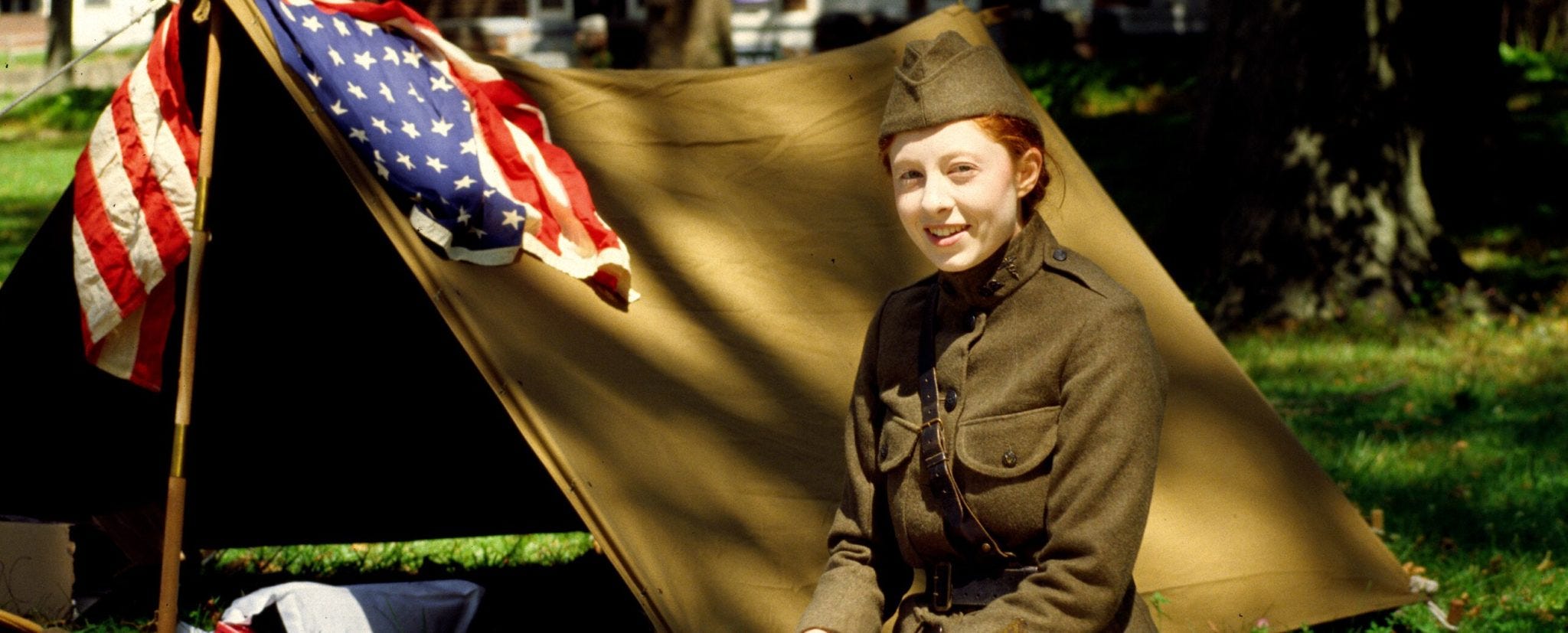This Millennial’s Alter Ego is a Forgotten Female Surgeon From WWI
Most war reenactors are older men, but 27-year-old Lillian Fehler stands out for designing uniforms that are historically accurate down to the tiniest details.
On a sunny morning last September in the grassy hills of Governors Island, New York City, 27-year-old Lillian Fehler woke to the bright, warbling call of a military bugle. She sat up inside her camping tent (an authentic green cloth tent that soldiers actually used during World War I), and laced up her boots. The boots were authentic, too — impeccably restored to mint marching condition by Fehler herself, who studied at the Fashion Institute of Technology. Next, she brushed her striking red hair into a bun, snapped up the highest button on her stiff collar, and ducked out into the light of day, where she was greeted with a historically accurate breakfast, prepared on historically accurate cookware.
The event was Camp Doughboy — a three-day campout for living historians that also welcomed more than 3,000 curious visitors into its midst each day. Even the location had historical resonance: Governors Island (a 15-minute ferry ride from the lower tip of Manhattan) served as an active military base during WWI. Today, the site is cared for by the Trust for Governors Island, and Camp Doughboy is the result of a collaboration between this trust, the National Parks Service, and the WWI Centennial Commission — which was created by Congress in 2013 to “honor, commemorate and educate.” Thirty or so dedicated historical reenactors like Fehler were in attendance, and they had brought an astonishing array of items from their personal museum collections (rusty bicycles! bayonets! binoculars!) to show off to each other over the weekend. Since its start in 2016, Camp Doughboy has grown to be one of the largest historical gatherings in New York City.
“Where did you get this uniform?” a curious woman asked Fehler, while testing the fabric of Fehler’s sleeve between her fingers.
“Hoo boy,” Fehler smiled impishly before launching into a scarily precise explanation. She had stitched her WWI uniform herself using a 1916 dressmaker’s diagram as a guide, and she’d raided antique fairs and obscure corners of the internet to find the original hat and leather belts. She also had a lot of critiques to share about various vendors of rare dyes and chemicals, stemming from her rigorous training as a textile conservationist and theatrical costumer. The results of Fehler’s intense nerdery and hours of labor showed: She was quite arguably the most photogenic living historian to show up at Camp Doughboy. Not only was she a singularly pretty model for her own clothes, but she also stood out for being one of the youngest participants — and one of the only women.
Fehler was performing the persona of Dr. Anna Tjomsland, a real-life surgeon who served in WWI — and whom Fehler had researched meticulously. Dr. Tjomsland was one of about 55 female surgeons to put on a uniform for the American military during the First World War, and one of only 11 to get assigned overseas. Fehler knew this because she had pored through Dr. Tjomsland’s letters and possessions in university library archives. Many of these letters dated back to 1918 and earlier, but to Fehler they remained very much alive. She discovered them while pursuing her master’s degree, and she was annoyed to learn how easily the story of such a unique and independent female doctor could be forgotten by history. Looking around the grassy field at Camp Doughboy, the absence of women in the military history books seems to have translated into the niche community of cosplay and reenactment. Only a handful women showed up to the event in costume.
“There has been some amount of unpleasantness aimed at newer female reenactors and living historians,” Fehler explains. “I have not encountered it as much, personally, but my friends could tell you that there are men who don’t want women involved because they see this as going back to the ‘good old days.’ Of course, the ‘good old days’ didn’t exist, but to them the ‘good old days’ meant men were men and women were below them. I don’t want to come off as saying the men are horrible though. For the most part, the men in historical reenactment are good and supportive.”


